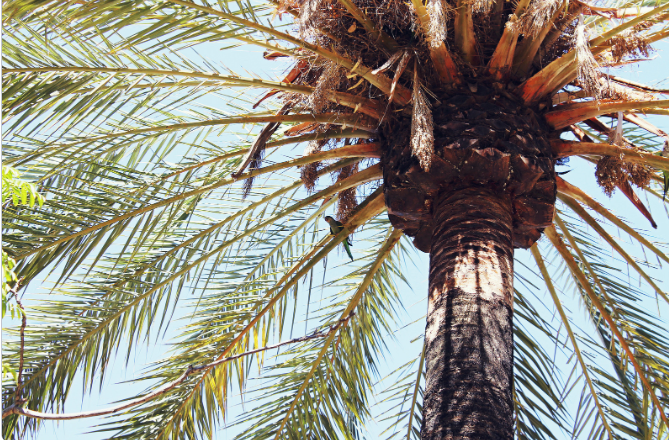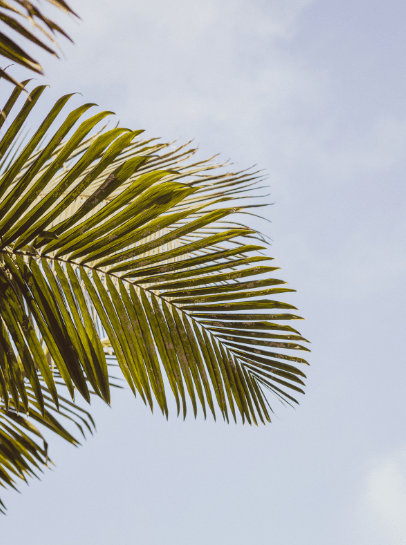
Chinch Bugs vs. Sod Webworms: Spotting the Difference in Your Florida Lawn
Whether you’re a new homeowner in Florida or a long-time resident, you already know that conditions in the Sunshine State…

Palm trees are a treasured part of the Florida landscape, adding a lush, tropical feel to any space they adorn. From towering royal palms lining driveways to clusters of pygmy dates around pools, palms are a quintessential part of our scenery. However, despite their carefree appearance, palm trees are susceptible to a number of diseases that can cause unsightly damage and even death if left untreated. As a homeowner, landscaper, or palm enthusiast, it’s important to be aware of common palm tree diseases so you can keep your palms healthy and thriving.
At Council Oxford, we’ve been providing expert agricultural solutions to all of central Florida for decades. Headquartered in rustic Ruskin and serving everyone from large golf courses to individual homeowners, we’ve seen firsthand the devastating effects that diseases of palm trees can have. In this article, we’ll share our knowledge on the most prevalent palm tree diseases in our region, the key symptoms to look out for, and our best tips for prevention and treatment.
Two of the most serious diseases affecting palms in Florida are lethal yellowing and lethal bronzing. While similar, there are some key differences between these deadly diseases. Lethal yellowing will cause fronds to turn yellow, while lethal bronzing leads to a distinctive bronze coloration. Both diseases cause fronds to die from the bottom of the canopy up.
Lethal yellowing and lethal bronzing are caused by phytoplasmas, bacterial infections spread by small plant-hopping insects. They affect over 30 palm species including the iconic coconut palm and the prized Christmas palm. In addition to frond discoloration, other symptoms include:
Unfortunately, there is no cure for lethal yellowing or lethal bronzing once a palm is infected. The best prevention is planting resistant palm varieties like the stately sylvester palm or the hardy sabal palm. Properly pruning and maintaining palms to avoid stress and wounds can also help them resist infection. If a palm does contract lethal yellowing or lethal bronzing, antibiotic injections may prolong its life but will not cure the disease. Sadly, most palms with over 25% discolored leaves should be removed to prevent disease spread.
Ganoderma butt rot is another deadly palm tree fungus with no known cure. It is caused by the wood-decaying fungus Ganoderma zonatum entering the palm through wounds, especially in the lower 4-5 feet of the trunk. The most notable sign of infection is the development of a conk, a distinctive mushroom-like growth, at the base of the trunk. Affected palms will also exhibit an overall slower growth rate and decline. Other symptoms appear on the oldest leaves first and include:
As the fungus slowly destroys the palm’s vascular system from the ground up, water and nutrient transport to the canopy is blocked, leading to wilt and frond death. To prevent Ganoderma infection, avoid any damage to the trunk and root system when doing landscaping work. Also, do not replant new palms in areas where others have died of Ganoderma butt rot as the fungus persists in the soil and roots for years. Once a palm develops a conk, it should be removed and destroyed to limit disease spread.

Yet another soil-borne fungus, Fusarium oxysporum, is behind the lethal vascular disease Fusarium wilt. It most commonly affects Canary Island date palms and is especially deadly for that species. Symptoms are similar to Ganoderma butt rot, with the oldest leaves usually showing signs first:
Like Ganoderma, Fusarium wilt clogs the water-conducting tissues, leading to leaf wilt and death as the disease progresses up the trunk. There are currently no effective chemical controls for this fatal disease, so prevention is key. Avoid planting Canary Island date palms in areas where this disease is present. Never replant a palm in a spot where one died of Fusarium wilt as the fungus remains viable in the soil for over 25 years. If you have multiple palms, always disinfect pruning tools between trees to avoid spreading the infection. While no cure exists, supportive care such as proper fertilization and irrigation may prolong an infected palm’s life. If you catch the disease early, remove infected lower fronds immediately and treat the pruned areas with a fungicide like liquid copper or chlorothalonil to help limit spread. Monitor the palm closely and remove it promptly if the disease progresses.
If you’re wondering “why are my palm leaves turning yellow?” or “why are the tips of my palm fronds turning brown?”, nutritional deficiencies may be to blame. The sandy soils that are so common in Florida tend to be nutrient-poor, lacking sufficient levels of many of the key elements palms need to thrive.
Most palms need supplemental nutrition in the form of regular fertilization to look their best. The nutrients most commonly deficient in Florida soils and critical for healthy palms include:
While nutritional deficiencies are rarely fatal, they diminish the beauty and health of your palms. The most common symptoms of nutrient deficiency include:
 In Florida landscapes, potassium deficiency is especially prevalent due to our sandy, potassium-poor soils. Magnesium and manganese deficiencies are the most common micronutrient issues, causing that yellowing and browning of fronds so often seen.
In Florida landscapes, potassium deficiency is especially prevalent due to our sandy, potassium-poor soils. Magnesium and manganese deficiencies are the most common micronutrient issues, causing that yellowing and browning of fronds so often seen.
The good news is, unlike diseases, nutritional deficiencies can be reversed if caught early enough. Council Oxford always recommends using our custom-blended 12-4-12 fertilizer that contains all the key elements Florida palms need including nitrogen, phosphate, potassium, manganese, magnesium, iron and boron. This slow-release, granular formulation should be applied every 3-4 months throughout the year for optimal palm nutrition.
In addition to regular fertilization, performing periodic soil tests can help you fine-tune your palm nutrition program and detect any nutrient imbalances before they manifest as deficiency symptoms. Foliar sprays containing micronutrients like manganese or magnesium can provide a quick boost to correct deficiencies while waiting for root uptake of granular fertilizers to kick in. Adjusting soil pH is also important, as Florida’s often acidic soils can interfere with proper nutrient uptake. Adding lime periodically can help maintain the slightly acidic to neutral pH range that palms prefer.
While some palm tree diseases like lethal yellowing and Fusarium wilt can fell even properly cared for palms, following good cultural practices consistently is still the best way to defend against disease and keep your palms looking their best.
One of the easiest ways to avoid disease issues is to choose palm species that have demonstrated natural resistance to common diseases. While no palm is completely immune, varieties that have the best track record against lethal yellowing, Ganoderma butt rot and Fusarium wilt include:
While the tall, stately Canary Island date palm is a popular choice for lining driveways and streets, it is especially susceptible to Fusarium wilt. If you love the look but want to reduce disease risk, opt for the resistant ‘Medjool’ or ‘Zahidi’ varieties. For a similar silhouette, consider the disease-resistant sylvester palm instead.
Keeping palms healthy with proper care goes a long way in preventing and recovering from disease. An integrated pest management (IPM) approach combines cultural, biological and chemical methods to give your palms the best environment to thrive. Key components of palm IPM include:
Pruning, when done properly, not only keeps your palms looking tidy, but also helps prevent and control disease. Immediately removing any dead, declining or discolored fronds and disposing of them (not composting them) helps to limit disease spread. Just be sure to disinfect your pruning tools between trees with a 50/50 bleach solution or by flaming the blades with a handheld torch to avoid inadvertently spreading fungal spores or bacteria. Also avoid any rough cuts or trunk wounds that could serve as entry points for disease. Climbing spikes should never be used on palms. For a final defense, treat any pruning cuts with a fungicide to discourage fungal growth.
Proper pruning and care after storm damage is also critical for preventing disease from gaining a foothold. High winds can uproot entire trees or cause substantial canopy and trunk damage. Flooding, especially from saltwater storm surge, can also seriously stress palms. It’s generally best to wait until after storm season has passed to do any major pruning, as it stimulates new growth that is especially susceptible to damage. Once a storm has passed, assess your palms carefully. Remove any damaged or hanging fronds, and treat the pruned areas with a fungicide. Stand up any downed palms and stake them. If salinity is an issue, irrigate thoroughly to leach excess salts. Lastly, avoid fertilizing until any standing water has drained to avoid root burn.
Even with excellent care, palm diseases can sometimes take hold. Many can quickly turn deadly if not properly diagnosed and dealt with. It’s important to consult with a professional if you suspect any disease or notice any abnormalities in your palms.
Here at Council Oxford, our experienced team can quickly identify disease issues and recommend the best strategies to treat infected palms or replace them if needed. We’re also happy to develop a customized care plan incorporating the best disease-resistant varieties, cultural care practices and fertilizers to keep all your palms looking their best. Contact us today for all your palm care needs!
Your slice of paradise deserves the very best care. By understanding the common diseases and deficiencies that affect our palms and taking proactive steps to prevent and manage them, you can keep your palms thriving for years to come.
Council Oxford has been providing unparalleled agricultural expertise to all of central Florida for 40 years. From palm disease diagnostics to premium fertilizer blends, we’re your trusted partner in growing success. Stop wondering why your palm fronds are yellow and contact us today!
